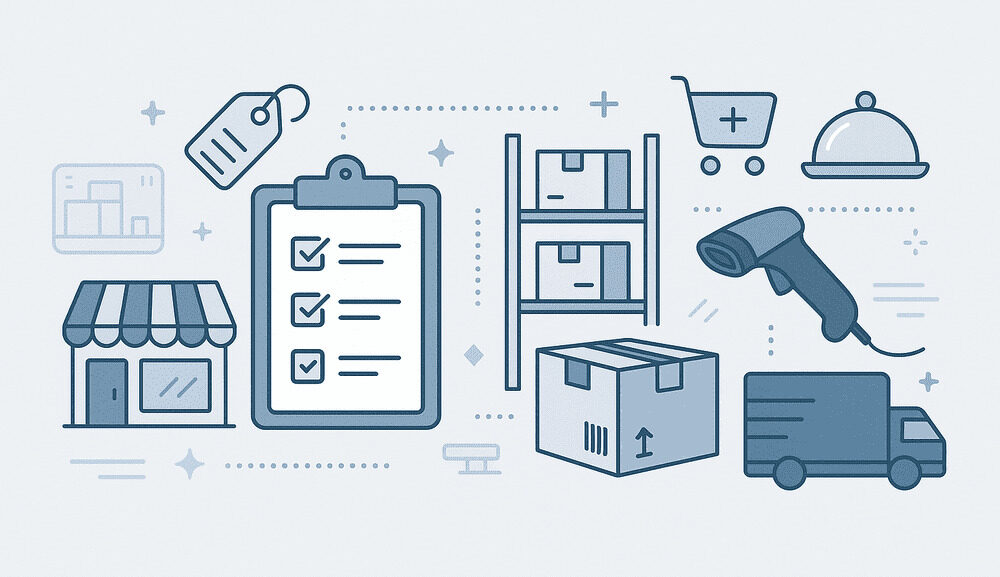
Inventory management is vital for small businesses in any category. When you apply effective inventory management strategies, you free up cash flow, prevent waste, and ensure you can meet customer demand at all times. But without solid inventory management strategies, you risk lost sales, spoiled inventory, and money tied up in unsold stock.
But the optimal method—and the optimal inventory management techniques—aren’t one-size-fits-all. A retail store, restaurant, e-commerce retailer, and services company all have various inventory concerns.
In this guide, we’ll illustrate real-world inventory management techniques by business type, with descriptions of the types of tools you can utilize in each.
Why Small Businesses Need Good Inventory Management Strategies
Inventory is typically your largest investment after staff and rent. Without sound systems:
- You overstock and waste money.
- You understock and miss sales.
- You spend time searching for what you need.
- You can’t prepare for peak periods.
Implementing the proper inventory management techniques guarantees that you always know what you have, what you require, and when you should restock.
1. Retail Stores
Retailers are confronted with diverse product lines, supplier lead times, and seasonal fluctuations in demand. Effective inventory management techniques here reduce overstocking and prevent stockouts.
a. Exhaustive Stock Classification
Strategy: Categorize products into groups based on value and turnover (fast vs. slow movers).
- Fast-moving/high-value items are given more attention.
- Slow-movers can have more lenient controls.
Best Tool Type: Inventory management software with user-defined product categories.
Why? Enables you to categorize and filter items by category, so you can generate custom reorder reports for each.
Strategy: Store stock with effective labeling, fixed locations, and rational grouping.
b. Physical Organization of Inventory
Best Tool Type: Barcode labeling systems (hardware + software).
Why? Barcoding reduces human error in stocking and picking. Tools help in label design and printing, and scanners update stock levels in real time.
c. Reorder Point Management
Strategy: Set minimum inventory levels for every item that trigger a new order when they are reached.
Best Tool Type: Inventory software with automatic reorder alerts.
Why? These tools notify you when inventory reaches predefined levels, preventing stockouts without constant manual monitoring.
d. Cycle Counting
Strategy: Count a portion of inventory on a rolling basis instead of shutting down for a massive year-end count.
Best Tool Type: Cycle count software with scheduling functionality.
Why? Enables you to schedule and track cycle count activities, record variances in real time, and confirm all SKUs are counted on schedule.
e. Seasonal Demand Planning
Strategy: Analyze historical sales to forecast demand peaks.
Best Tool Type: Analytics and reporting dashboards.
Why? Helps visualize trends and forecast demand to make smarter pre-season ordering.
2. Restaurants and Cafés
Food businesses are prone to spoilage, fluctuating demand, and thin margins. Their inventory management practices must prioritize accuracy.
a. First-In, First-Out (FIFO)
Strategy: Inventory items in a manner that older stock is always utilized first.
Best Tool Type: Labeling systems with date monitoring.
Why? Labels make FIFO easy even for harried staff.
b. Recipe and Portion Control
Strategy: Standardize recipes with precise portion sizes.
Best Tool Type: Recipe costing and portion control software.
Why? Lets you input recipes and yields, and it calculates ingredient needs and cost per serving automatically.
c. Par Level Setting
Strategy: Establish minimum quantities (par levels) for all ingredients.
Best Tool Type: Inventory systems with par-level tracking.
Why? Monitors existing inventory versus par levels, indicating items to reorder.
d. Waste Tracking
Strategy: Document all waste, spoilage, and returns daily.
Best Tool Type: Digital waste logs.
Why? Tracks trends over time to reduce waste.
e. Make Regular Inventory Checks
Strategy: Count high-value perishables daily, bulk items weekly.
Best Tool Type: Inventory sheet templates integrated into stock systems.
Why? Standardized templates speed up checks and input data automatically into inventory records.
3. E-commerce Businesses
E-commerce retailers oversee online channels, suppliers, and perhaps warehouses. Their inventory management strategies must deliver precise real-time information.
a. Centralized Inventory Tracking
Strategy: Maintain a single source of truth across all sales channels.
Best Tool Type: Multi-channel inventory management software.
Why? Synchronizes stock levels in real-time across your website, marketplaces, and physical stores.
b. Demand Forecasting by Channel
Strategy: Project future sales by channel based on historical history.
Best Tool Type: Analytics and forecasting modules.
Why? Enables smarter purchasing with firm projections.
c. Safety/Buffer Stock Management
Strategy: Maintain a buffer of key items for demand spikes.
Best Tool Type: Inventory systems with safety stock parameters.
Why? Alerts you when actual stock dips below safety stock, initiating reorders.
d. Batch and Lot Tracking
Strategy: Track which supplier batch or lot each item is from.
Best Tool Type: Batch/lot tracking modules.
Why? Essential for traceability, especially for regulated or perishable items.
e. Returns Processing
Strategy: Inspect, record, and restock or discard returned goods.
Best Tool Type: Returns management systems.
Why? Automates procedures, updates inventory levels, and reduces errors.
4. Service Businesses
Even service companies often need efficient inventory management techniques for supplies, spare parts, or equipment.
a. Visual Inventory Control
Strategy: Keep supplies in open view with labels and assigned locations.
Best Tool Type: Bin labels and visual inventory boards.
Why? Allows for quick visual inspections without complex systems.
b. Reorder Triggers
Strategy: Set minimum stock levels for critical items.
Best Tool Type: Simple reorder-point tracking systems (electronic or spreadsheet).
Why? Notifies items hitting minimum levels, preventing stockouts.
c. Consumption Logs
Strategy: Record all usage of parts or supplies.
Best Tool Type: Electronic logs or spreadsheets.
Why? Tracks consumption patterns to prevent overuse or theft.
d. Inventory Kitting
Strategy: Pre-package materials needed for specific jobs or service calls.
Best Tool Type: Kitting and assembly tracking tools.
Why? Contains all necessary parts on hand before dispatch, which raises efficiency.
Universal Best Practices for Inventory Management Strategies
These inventory management strategies apply to any small business:
a. Accurate Record Keeping
- Tool Type: Centralized inventory databases or spreadsheets.
- Why? Maintains consistency of data, reducing duplication and errors.
b. Staff Training
- Tool Type: Electronic checklists or training materials.
- Why? Formalizes procedures to reduce repetitive errors.
c. Supplier Relationship Management
- Tool Type: Order history records and supplier contact lists.
- Why? Tracks performance, terms, and correspondence for better negotiations.
d. Periodic Full Audits
- Tool Type: Checklists or audit planning tools.
- Why? Ensures no inventory section is left out.
e. Continuous Improvement
- Tool Type: Trend analysis reporting dashboards.
- Why? Identifies waste, slow movers, or demand shifts.
Conclusion
Managing inventory is more than just counting goods. It’s about applying the right inventory management strategies and tools to your business type.
- Retailers need classification, cycle counting, and reorder points with stock-tracking and barcoding systems.
- Restaurants value FIFO, portion control, waste tracking, and par-level tracking with recipe and labeling systems most.
- E-commerce retailers rely on multi-channel, centralized inventory systems with batch tracking and returns management.
- Service firms utilize visual controls, logs, and kitting systems.
By choosing the right inventory management techniques + the right type of tool, you’ll be more accurate, reduce costs, and better serve your customers—no matter what kind of small business you have.


